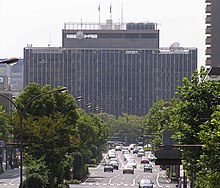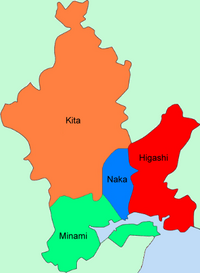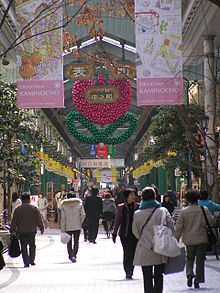Okayama
Okayama (岡山市, Okayama-shi) is the capital city of Okayama Prefecture in the Chūgoku region of Japan.
The city was founded on June 1, 1889. As of August 2010, the city has an estimated population of 705,224 and the density of 893 persons per km². The total area is 789.88 per square kilometer.
The city is the site of Kōraku-en and the black Okayama Castle, which is ranked among the best 100 Japanese castles. The city is famous as the setting of the Japanese fable "Momotarō".
History
This section may require copy editing. (December 2009) |
Sengoku period to Tensho era

Before the Muromachi period, Okayama was one corner of a farm region and included a small castle build by the Kanemitsu. In the Sengoku period, Ukita Naoie attacked Okayama and robbed the castle in pursuit of the transportation resources and extensive farmland in the region. Naoie remodeled the castle, built the old Sanyo road to the central part of the castle town, and called in tradesmen from inside and outside of Bizen province. Okayama became the political and economical capital of Bizen province.
Edo period
In 1600, Ukita Hideie, who was son of Naoie and the lord of Okayama, lost at the Battle of Sekigahara. The next year, Kobayakawa Hideaki came to Okayama and became the feudal lord of Okayama Domain. But Hideaki died in 1602 and ended the Kobayakawa line. Ikeda Tadatugu, who was the feudal lord of Himeji Domain, next became the lord of Okayama. After this time, Okayama was ruled over by the Ikedas until the latter part of the 19th century. Continuting its economic development, Okayama became one of the 10 best large castle towns in Japan in the 18th century. The Korakuen Garden was developed by the 4th feudal lord, Ikeda Tsunamasa.
Meiji Restoration to World War II

On August 29, 1871, the new Meiji government of the Empire of Japan replaced the traditional feudal domain system with centralized government authority (Prefectures of Japan). Okayama became the capital of Okayama Prefecture. In 1889, Okayama city was founded. In the Meiji period, a railroad was built in Okayama city that greatly enhanced the development of the city. For example, the Sixth Higher Middle School (第六高等学校, Dairoku Kōtōgakkō)and Okayama Medical College (岡山医科大学, Okayama Ika-daigaku) were established in Okayama city. Okayama became one of the most important places in western Japan for transportation and education. When World War II broke out in the 1940s, Okayama city had a Japanese Army base camp. On June 29, 1945, the city was attacked by the US Army with incendiary bombs. Almost all the city was burned out and many people died.[quantify] Okayama suffered terrible damage in the war.
Since World War II
During Japan's economic miracle of the 1960s, Okayama developed rapidly as one of the most important cities in the Chūgoku and Shikoku regions. In 1972, the Sanyō Shinkansen began service between Shin-Ōsaka and Okayama stations. Two years later, Shinkansen service was extended to Hakata.
In 1988, the Seto-Ōhashi Bridge was opened and connected Okayama with Shikoku directly by rail and road.
The city became a core city in 1996 and a designated city on April 1, 2009.[1]
Geography


The city of Okayama is located in the southern part of Okayama Prefecture, which in turn is located in western part of the island of Honshū. The city is bounded on the south by the Inland Sea.
Since Okayama became a designated city in 2009, the city has been divided into four wards (ku).
| Ward | Population | Area (km²) | Density (per km²) |
Map |
|---|---|---|---|---|
| Kita-ku (administrative center) |
295,312 | 451.03 | 655 | 
|
| Naka-ku | 138,949 | 51.24 | 2,711 | |
| Higashi-ku | 96,718 | 160.28 | 603 | |
| Minami-ku | 165,193 | 127.36 | 1,297 | |
| Population as of October 1, 2005 | ||||
Mergers
- On March 22, 2005, the town of Mitsu, from Mitsu District, and the town of Nadasaki, from Kojima District, merged into the city of Okayama.
- On January 22, 2007, the town of Takebe, from Mitsu District, and the town of Seto, from Akaiwa District, merged into the city of Okayama.
Kojima, Mitsu, and Akaiwa districts have all since been dissolved.
Climate
Okayama has a mild climate in comparison to most of Japan. The city is ranked as the second driest and the fourth sunniest city in the Chūgoku region.[2] The climate is classified under the Köppen climate classification as Humid Subtropical Cfa.[3][4]
The local climate is warm enough throughout the year to support olive trees. Okayama is often called "The Sunny Country" because of its low rainfall.[5]
Economy

Agriculture
The city is located in the Okayama Plain, where rice, eggplant, and white Chinese chives are notable products.[6] White peaches and grapes are cultivated in the mountainous, northern part of the city.
Industry
In 2005, the city's gross domestic product was 800 billion yen,[7] nearly 10% of the GDP of Okayama Prefecture. The main industries are machine tools, chemicals, foodstuffs and printing. Kōnan, a district in the southern part of the city, is the most developed industrial zone.
Commerce
Okayama is the core of the Okayama metropolitan area, which includes the cities of Kurashiki and Sōja. The main commercial district is Omotechō, near Okayama Castle and Kōrakuen, and the area surrounding Okayama Station. Omotechō has many covered shopping arcades.
The headquarters of Aeon Corporation, a private English language school with more than 3,000 employees, is located in Okayama.[8]
Culture

Okayama Castle and Kōraku-en are Okayama's most notable attractions.
Okayama Castle (nicknamed Ujō (烏城), meaning "crow castle") was constructed in 1597 by Ukita Naoie, a Japanese feudal lord. It was destroyed by bombing in 1945 during World War II but reconstructed in 1966.
Kōraku-en, known as one of the three best traditional gardens in Japan, lies south of the castle grounds. Kōrakuen was constructed by Ikeda Tsunamasa over 14 years, and completed in 1700.
Sōgen-ji, a large Buddhist monastery belonging to the Rinzai sect, is located near the center of the city. Several of the abbots of major monasteries in Kyoto are from Sōgen-ji.[citation needed]
Music and the arts
Okayama has a professional symphony orchestra, the Okayama Symphony Orchestra, which performs at the Okayama Symphony Hall.
There are many museums in the city, including the Okayama Prefectural Museum, the Okayama Prefectural Museum of Art, the Hayashibara Museum of Art, the Yumeji Art Museum, and the Okayama Digital Museum.
Cuisine
Okayama has several traditional dishes. Barazushi (ばらずし), a dish made with sushi rice, contains fresh fish from the Seto Inland Sea. Kibidango (吉備団子), a cake made from a powder of millet and rice, is also famous.
Media

The Sanyo Shimbun and the Okayama Nichinichi Shimbun are the local newspapers serving the greater Okayama area. The former publishes both morning and evening editions while the latter publishes an evening edition only. There are six television stations serving the Okayama area and part of Kagawa Prefecture. Three FM and three AM radio stations also serve the region.
- TV Stations
| Channel ID | Name | Network | Established year | Call sign |
|---|---|---|---|---|
| 1 | NHK General TV Okayama | NHK General TV | 1957 | JOKK-(D)TV |
| 2 | NHK Educational TV Okayama | NHK Educational TV | 1963 | JOKB-(D)TV |
| 4 | Nishinippon Broadcasting Co.,Ltd.(RNC) | NNN | 1958 | JOKF-(D)TV |
| 5 | Setonaikai Broadcasting Co.,Ltd.(KSB) | ANN | 1969 | JOVH-(D)TV |
| 6 | Sanyo Broadcasting Co.,Ltd.(RSK) | JNN | 1958 | JOYR-(D)TV |
| 7 | TV Setouchi Broadcasting Co.,Ltd.(TSC) | TXN | 1985 | JOPH-(D)TV |
| 8 | Okayama Broadcasting Co.,Ltd.(OHK) | FNN | 1969 | JOOH-(D)TV |
- Radio Stations
| Channel | Name | Network | Established year | Call sign |
|---|---|---|---|---|
| AM 603 kHz | NHK Radio Daiichi Okayama | NHK Radio Daiichi | 1931 | JOKK |
| AM 1386 kHz | NHK Radio Daini Okayama | NHK Radio Daini | 1946 | JOKB |
| AM 1494 kHz | Sanyo Broadcasting Co,Ltd.Radio (RSK) | JRN, NRN | 1958 | JOYR |
| FM 88.7 MHz | NHK FM Okayama | NHK FM | 1964 | JOKK-FM |
| FM 76.8 MHz | FM Okayama | JFN | 1999 | JOVV-FM |
| FM 79.0 MHz | Radio MOMO (Okayama City FM) | J-WAVE | 1997 | JOZZ8AD-FM |
Sports
Okayama has many sports teams. In recent years, volleyball team Okayama Seagulls and football club Fagiano Okayama have been established. In 2009, Fagiano Okayama FC gained promotion to the J. League, the highest football league in Japan.
| Club | Sport | League | Venue | Established |
|---|---|---|---|---|
| Fagiano Okayama FC | Football | J. League Division 2 | Momotaro Stadium (Okayama Prefectural Multipurpose Athletic Stadium) | 2004 |
| Okayama Seagulls | Volleyball | V.League | Momotaro Arena (Okayama Prefectural Multipurpose Grounds Gym) | 1999 |
| Serio Standing Bears | American football | X-League | Momotaro Stadium (Okayama Prefectural Multipurpose Athletic Stadium) | ? |
| Citylight Okayama Baseball Team | Baseball | Semi-professional baseball | 2008 |
Education

Okayama University, founded as a medical school in 1870 and established in 1949 as a national university, is located in the city. Today, Okayama University is one of Okayama's largest universities, with 11 faculties and 6 graduate schools.
There are seven private universities, three junior colleges, 24 high schools (16 public, 8 private), seven combined junior high/high schools (2 public, 5 private), 37 junior high schools (36 municipal, 1 national) and 93 elementary schools (91 municipal, 2 private) located in the city.
- Universities
- Okayama University (National)
- Notre Dame Seishin University (Private)
- Okayama University of Science (Private)
- Okayama Shoka University (Private)
- Sanyo Gakuen University (Private)
- Shujitsu University (Private)
- Chugoku Gakuen University (Private)
- International Pacific University (Private)
Transportation

Intercity rail
JR West's Okayama Station is a major interchange, with trains from Shikoku, San'in and San'yo connecting to the Sanyō Shinkansen. Local rail lines serving Okayama Station include:
Tramway
Okayama is one of few Japanese cities to have kept an operational tram system since the Meiji period. It is managed by Okayama Electric Tramway and offers two lines: the Higashiyama Main Line and the Seikibashi Line.
Bus
Seven bus companies provide service within the city limits:
- Bihoku Bus (備北バス)
- Chūtetsu Bus (中鉄バス)
- Okaden Bus (岡電バス)
- Ryōbi Bus (両備バス)
- Shimoden Bus (下電バス)
- Tōbi Bus (東備バス)
- Uno Bus (宇野バス)
Air
Okayama Airport, located in the northern part of the city, provides domestic service to Tokyo-Haneda, Sapporo-Chitose, Okinawa-Naha, and Kagoshima. International air service is provided to Seoul-Incheon, Guam, Beijing, Shanghai-Pudong, and Dalian.
Commuter air service is also available from Kōnan Airport.
Notable people
- Shin Koyamada (Hollywood/Japanese actor, Entrepreneur) - Born and raised in Okayama co-starred in the Warner Bros' epic feature film The Last Samurai as Nobutada and starring in Disney Channel Original Movie Wendy Wu: Homecoming Warrior as Shen.
- Akihiko Kumashiro - three-time member of the House of Representatives of Japan
- Masashi Kishimoto-mangaka and creator of Naruto.
Sister cities
Okayama has 6 sister cities around the world.
 San Jose, California, United States (1957)
San Jose, California, United States (1957) San José, Costa Rica (1969)
San José, Costa Rica (1969) Plovdiv, Bulgaria (1972)
Plovdiv, Bulgaria (1972) Luoyang, China (1981)
Luoyang, China (1981) Bucheon, South Korea (2002)
Bucheon, South Korea (2002) Hsinchu City, Taiwan (2003)
Hsinchu City, Taiwan (2003)
Points of interest
- Korakuen Garden
- Tokoen Garden
- Omizuen Garden
- Handayama Botanical Garden
- RSK Rose Garden
- Okayama Castle
- Okayama Prefectural Museum
- Okayama Orient Museum
- Okayama Prefectural Museum of Art
- Hayashibara Museum of Art
- Yumeji Art Museum
- Ikeda Zoo
- Kibiji District Cycling Road
- Ashimori Clan Samurai Residence
- Saijo Inari
- Kibitsu Shrine
- Kibitsuhiko Shrine
- Tsukuriyama Kofun
- Saidaiji Temple (Okayama)
- Sogenji Temple
- Okayama Symphony Hall
- Okayama University
References
- ^ http://www.kokudo.or.jp/marge/c_okayama.html Template:Ja
- ^ http://www.pref.okayama.jp/kikaku/kokusai/momo/e/gaiyou/gaiyou.html
- ^ http://koeppen-geiger.vu-wien.ac.at/
- ^ http://www.weather.com/outlook/travel/businesstraveler/wxclimatology/monthly/graph/JAXX0065?from=36hr_bottomnav_business
- ^ http://www.pref.okayama.jp/soshiki/detail.html?lif_id=2143
- ^ http://www.city.okayama.jp/kankou/aji/index.html
- ^ http://www.city.okayama.jp/soumu/toukei/kougyou/17kougyou/gaiyou.pdf
- ^ Aeon Corporate Structure
External links
- Articles needing cleanup from December 2009
- Cleanup tagged articles without a reason field from December 2009
- Wikipedia pages needing cleanup from December 2009
- Wikipedia articles needing copy edit from December 2009
- Okayama
- Cities in Okayama Prefecture
- Port settlements in Japan
- Populated coastal places in Japan
